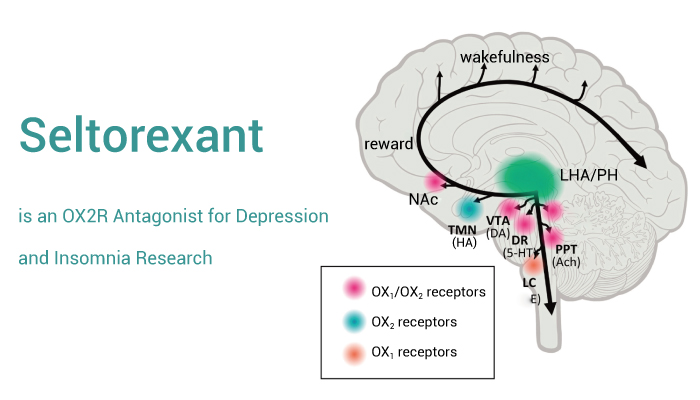The orexin system was discovered in 1998. Initially, they were identified as feeding behavior regulators. The neuropeptides orexin-A (hypocretin-1) and orexin-B (hypocretin-2) can produce by a cluster of neurons in the lateral hypothalamus and perifornical area. Orexin neurons receive and transmit signals related to environmental, physiological, and emotional stimuli throughout the central nervous system (CNS). The specific receptors (OX1R, OX2R) can control the activity of orexins.
In addition to regulating feeding patterns, orexin may play important roles in the coordination of emotion, energy homeostasis, reward, and arousal. Orexin neurons play a role in sensing the body’s external and internal environments and regulating sleep and wake states as needed for survival. Furthermore, there is evidence linking the influence of the orexin system to the development of depression. Today, we will intrduce an orexin-2 receptor (OX2R) antagonist — Seltorexant.
Seltorexant is an orally active, high-affinity, and selective OX2R antagonist.
First of all, Seltorexant (JNJ-42847922) has activity with pKi values of 8.0 and 8.1 for human and rat OX2R. Seltorexant crosses the blood-brain barrier and quickly occupies OX2R binding sites in the rat brain. Secondly, Seltorexant promotes and prolongs total sleep time. It (3-30 mg/kg; p.o.) dose-dependently induces and prolongs sleep in male Sprague-Dawley rats. Meanwhile, it also shortens latency to persistent sleep as well as wake after sleep onset. Importantly, it preserves sleep architecture and can be used in a treatment of hyperarousal insomnia characterized by overactivity of the HPA. In addition, the co-administration of Seltorexant (20 mg) with other antidepressant treatments improved the state of patients. Finally, the use of Seltorexant is safe with no indicate genotoxicity.
In a word, Seltorexant is an OX2R antagonist for depression and insomnia research.
Reference:
[1] Bonaventure P, et al. J Pharmacol Exp Ther. 2015 Sep;354(3):471-82.
[2] Ziemichód W, et al. Molecules. 2023 Apr 19;28(8):3575.
